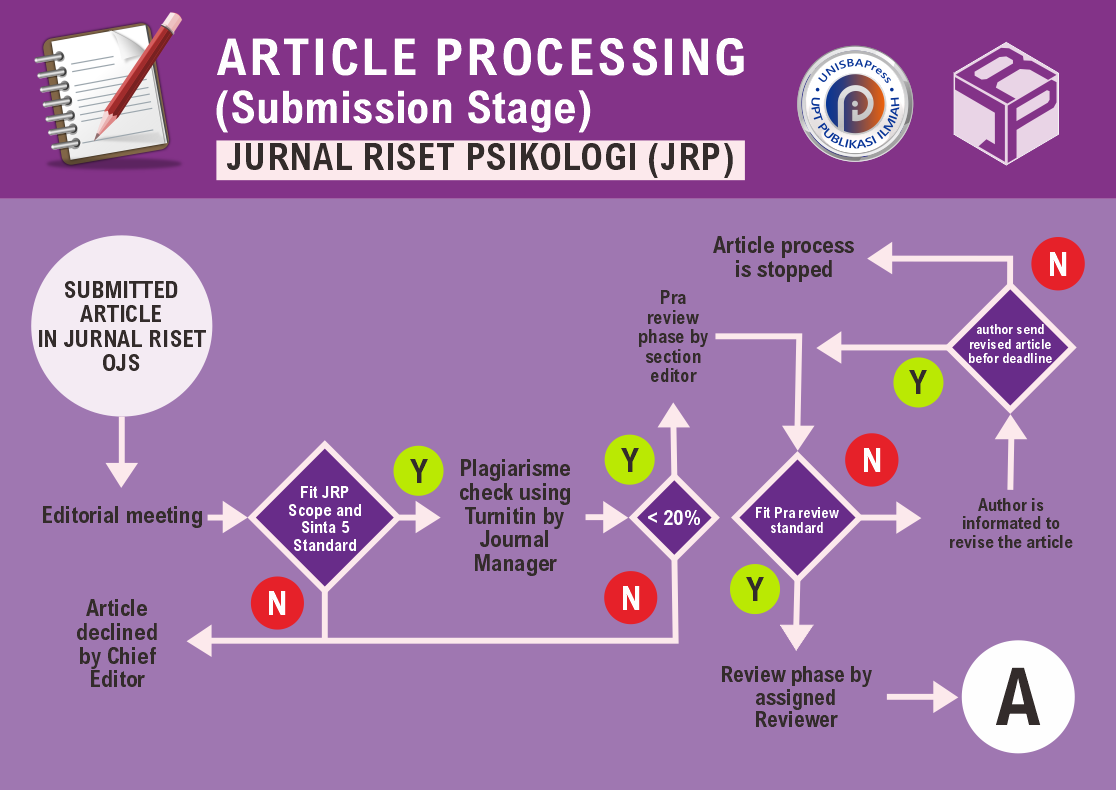Pengaruh Self presentation terhadap Subjective Wellbeing pada Emerging Adulthood Pengguna Instagram
DOI:
https://doi.org/10.29313/jrp.v3i1.1981Keywords:
Self Presentation, Subjective Wellbeing, InstagramAbstract
Abstract. Self-presentation is an effort made by a person to present themself as someone who can be accepted by others. An asynchronous and editable social media space allows one to selectively self-present to benefit, form and maintain at least some lasting, positive, and significant interpersonal relationships. These underlie the desire for acceptance and belongingness in human behavior and illustrate that there is evidence to suggest a strong positive relationship to positive emotions and satisfaction with life that is an aspect of subjective wellbeing. The purpose of this study is to obtain empirical data on the effect of self-presentation on subjective wellbeing on emerging adulthood Instagram users. The measurement in this study for the self-presentation and subjective wellbeing is using the Self Presentation on Facebook Questionnaire (SPFBQ) by Michikyan et al, Satisfaction With Life Scale (SWLS) and Scale of Positive and Negative Experience (SPANE) by Diener, which have been modified and adapted. The criteria for the respondents to this study were Instagram users aged 18-24 years in the city of Bandung, there were 157 respondents. Based on the results of data analysis, it was found that there was a significant influence of self-presentation on subjective wellbeing of 16% on subjective wellbeing of cognitive aspects and an influence of 7% on subjective wellbeing of affective aspects.
Abstrak. Self presentation merupakan usaha yang dilakukan seseorang untuk menampilkan dirinya sebagai seseorang yang bisa diterima oleh orang lain. Ruang media sosial yang asynchronous dan editable memungkinkan seseorang melakukan self presentation secara selektif untuk memberikan keuntungan, membentuk dan mempertahankan setidaknya beberapa hubungan interpersonal yang langgeng, positif, dan signifikan. Hal-hal tersebut mendasari keinginan untuk acceptance dan belongingness pada perilaku manusia dan memberikan gambaran bahwa ada bukti yang menunjukkan hubungan positif yang kuat terhadap emosi positif dan kepuasan terhadap kehidupan yang menjadi aspek dari subjective wellbeing. Tujuan dari penelitian ini adalah memperoleh data empiris mengenai pengaruh self presentation terhadap subjective wellbeing pada emerging adulthood pengguna Instagram. Pengumpulan data dilakukan menggunakan Self Presentation on Facebook Questionnaire (SPFBQ) oleh Michikyan dkk, Satisfaction With Life Scale (SWLS) dan Scale of Positive and Negative Experience (SPANE) oleh Diener, yang telah dimodifikasi dan diadaptasi. Adapun kriteria dari responden penelitian ini adalah pengguna Instagram berusia 18-24 tahun di kota Bandung didapatkan berjumlah 157 responden. Berdasarkan hasil pengolahan data, didapati adanya pengaruh self presentation terhadap subjective wellbeing yang signifikan sebesar 16% terhadap subjective wellbeing aspek kognitif dan pengaruh sebesar 7% terhadap subjective wellbeing aspek afektif.
References
[2] D. Smahel, B. B. Brown, and L. Blinka, “Associations between online friendship and internet addiction among adolescents and emerging adults,” Dev. Psychol., vol. 48, no. 2, pp. 381–388, 2012, doi: 10.1037/a0027025.
[3] Kemp, S. (11 Februari 2021). Digital 2021: Indonesia. Data Reportal: https://datareportal.com/reports/digital-2021-indonesia
[4] NapoleonCat. (November 2021). Facebook User in Indonesia: November 2021. NapoleonCat.: https://napoleoncat.com/stats/facebook-users-in-indonesia/2021/11/
[5] I. Amaral, “Instagram,” in The SAGE encyclopedia of economics and society, 1st ed., F. F. Wheery and J. B. Schor, Eds. SAGE Publication, 2015, pp. 943–944.
[6] K. Kircaburun and M. D. Griffiths, “Instagram addiction and the Big Five of personality: The mediating role of self-liking,” J. Behav. Addict., vol. 7, no. 1, pp. 158–170, 2018, doi: 10.1556/2006.7.2018.15.
[7] A. Attrill-Smith, C. Fullwood, M. Keep, and D. J. Kuss, The Oxford Handbook of Cyberpsychology. Oxford University Press, 2019.
[8] J. Kim and J. E. R. Lee, “The facebook paths to happiness: Effects of the number of Facebook friends and self-presentation on subjective well-being,” Cyberpsychology, Behav. Soc. Netw., vol. 14, no. 6, pp. 359–364, 2011, doi: 10.1089/cyber.2010.0374.
[9] S. Lyubomirsky, L. King, and E. Diener, “The benefits of frequent positive affect: Does happiness lead to success?,” Psychol. Bull., vol. 131, no. 6, pp. 803–855, 2005, doi: 10.1037/0033-2909.131.6.803.
[10] J. M. Tyler, K. E. Adams, and P. Kearns, “Self-presentation and subjective well-being,” in Subjective well-being and life satisfaction, J. E. Maddux, Ed. Routledge/Taylor & Francis Group, 2018, pp. 355–391.
[11] M. T. Whitty and G. Young, Cyberpsychology: The study of individuals, society and digital technologies. The British Psychological Society and John Wiley & Sons, Ltd., 2017.
[12] M. Michikyan, J. Dennis, and K. Subrahmanyam, “Can You Guess Who I Am? Real, Ideal, and False Self-Presentation on Facebook Among Emerging Adults,” Emerg. Adulthood, vol. 3, no. 1, pp. 55–64, 2014, doi: 10.1177/2167696814532442.
[13] B. A. Tama, “Validitas Skala Presentasi Diri Online,” J. Pengukuran Psikol. dan Pendidik. Indones., vol. 7, no. 1, pp. 1–7, 2019, doi: 10.15408/jp3i.v7i1.12102.
[14] E. Diener, R. A. Emmons, R. J. Larsen, and S. Griffin, “The Satisfaction With Life Scale,” J. Pers. Assess., vol. 49, no. 1, pp. 71–75, 1985, doi: 10.1207/s15327752jpa4901.
[15] Y. Natanael and Y. Novanto, “Pengujian Model Pengukuran Congeneric, Tau-Equivalent dan Parallel pada Satisfaction With Life Scale (SWLS),” Psympathic J. Ilm. Psikol., vol. 7, no. 2, pp. 285–298, 2021, doi: 10.15575/psy.v7i2.6405.
[16] E. Diener et al., “New Measures ofWell-Being,” in Assessing well-being: The collected works of Ed Diener, E. Diener, Ed. Springer Science + Business Media, 2009, pp. 247–266.
[17] C. B. Aryanto, “The Adaptation Process of the Scale of Positive and Negative Experience and the Flourishing Scale into Bahasa Indonesia : A Preliminary Study,” vol. 97, no. February, pp. 1–2, 2018, doi: 10.13140/RG.2.2.29432.55042.
[18] G. Lee, J. Lee, and S. Kwon, “Use of social-networking sites and subjective well-being: a study in South Korea.,” Cyberpsychol. Behav. Soc. Netw., vol. 14, no. 3, pp. 151–155, 2011, doi: 10.1089/cyber.2009.0382.
[19] S. Harter, S. Bresnick, H. A. Bouchey, and N. R. Whitesell, “The development of multiple role-related selves during adolescence,” Dev. Psychopathol., vol. 9, no. 4, pp. 835–853, 1997, doi: 10.1017/s0954579497001466.
[20] W. C. Compton and E. Hoffman, “Positive psychology: The science of happiness and flourishing (second edition),” Cengage Learn., p. 402, 2013.
[21] M. Michikyan, K. Subrahmanyam, and J. Dennis, “Can you tell who i am? Neuroticism, extraversion, and online self-presentation among young adults,” Comput. Human Behav., vol. 33, pp. 179–183, 2014, doi: 10.1016/j.chb.2014.01.010.













